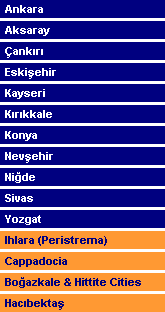| Konya... |
|
"Iconium" of the Roman times, is 263 km from Ankara. The land appears as a wide plateau, and has been continuously
inhabited even since the dates extending back to the 8th millenium BC. Catalhoyuk is an ancient city of that
period, which is considered to be one of the first settlement areas in the world, accommodating the earliest human
communities. Made up of mud houses, which were entered through holes in the roofs, this site is a real place of interest,
where you can feel the uppermost closeness to the life prevailing, long years ago. The finds from the district, including
the cult figures of the famous temple and the mother goddess, together with old frescoes, are now on display in the Museum
of Anatolian Civilizations in Ankara. In the environs of Konya, there also exist sites which hold some remains from the
Hittites. Ivriz is one, 168 km east of Konya, which comprises one of the finest Neo-Hittite reliefs in the country,
representing a king and the fertility god of the time. Eflatun Pinar is another important sight, which is a monumental
fountain of the Hittite age, constituting a holy place of the period. When the Byzantines came into rule, Konya became an
independent province, and was given the name "Lycanoia". Belonging to those times, is a Byzantine church and
several rock chapels filled with beautiful frescoes, which can be seen in the town of Sille, 8 km northwest of Konya,
where the first rock carved monasteries of the world were built. During the 12th and 13th centuries,
the city acted as the capital of the Seljuk Turks, and advanced rapidly to become a great cultural center. The most famous
building here, is the Green Mausoleum of Mevlana Celaleddin Rumi, the great Turkish philosopher and poet. He is the founder
of the sect of Whirling Dervishes, the seminary of which was attached to the mausoleum. It's now converted into a museum
housing Mevlana's works, and accoutrements related to his sect. Every year in December, ceremonies are held in Konya for
the Commemoration of Mevlana and the Whirling Dervishes. In this Dervish Festival, the "Sema" dance is performed
by men dressed in white robes, whirling and rotating around the floor. This dance, in which the dancer with the great love
of God is believed to attain divine unity, is an event well worth seeing. On Alaeddin Hill in this region, is the same
named mosque and palace, which are fine monuments built in the 13th century during the reign of the famous
Seljuk Sultan Alaeddin Keykubat.
|
|

|


 332...
332...
 42...
42...
 2,217,969...
2,217,969...
 38,257...
38,257...
 32 E 31 - 37 N 52...
32 E 31 - 37 N 52...









